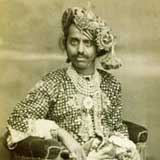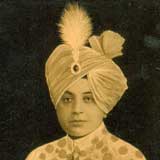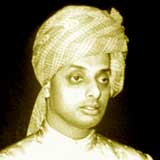

Rajpipla State History:
Rajpipla was known as Nandipuri or Nandipur during the rule of Gurjara kings, when it was the capital of the Lata kingdom. A later form of the name Nandol and Nandod have also been in use in medieval times and later.
 |
Rajpipla Flag |
Rajpipla State was situated largely between two important rivers of western India, the Narmada and the Tapti, with the Satpura range in the south. Spanning an area of over 1517 square miles (about 4,000 square kilometres), of which 600 square miles (1550 square kilometres) were forests, and the rest fertile agricultural plains and river valleys. Rajpipla grew to be one of the most prosperous princely states in Gujarat, second only to Baroda. It was also famous for its agate mines. Capital town of the state Nandod was renamed Rajpipla in 1947.
The history of the erstwhile Rajpipla Kingdom or Rajpipla State can be traced back to the early 14th century when Prince Chokrana, one of the Parmar Rajput heirs of Ujjain in the Malwa region of central India left his principality and travelled westwards to the wilder and hilly areas and founded a new kingdom. Initially, he set up his capital at a remote village Nandipur on the River Karjan. Since Chokrana belonged to the family of the famous King Bhoj, known for his scholarship and sense of justice, he too acquired a throne resembling Raja Bhoj’s famous royal throne of 32 icons of fairies. The village Nandipur is now known as Nandod, a part of the present day Rajpipla town. Soon the capital was shifted from Nandipur to Old Rajpipla or Juna Raj up in the western Satpuras. The new area was much safer as it was located, as it was, at a height of 2300 feet. It was well protected by hills, forests and deep gorges of the Karjan valley.
The daughter of Chokrana Parmar was married to Thakur Mokhdaji Ranoji (1309-1347) the Gohil Rajput Chief of Ghogha, with his capital at Pirambet in the Gulf of Cambay. Their son Kumar Shri Samarsinhji Mokhdaji Gohil, succeeded to the gadi of Junaraj (Old Rajpipla) on the death of his maternal grandfather Chokrana Parmar, who had no male issue. After coronation, Samarsinhji assumed the name Arjunsinhji and became the first Gohil Rajput ruler of Rajpipla around 1340 A.D.
Mokhdaji had an elder son Dungarsinhji from his first wife, a Sarvaiya princess of Hathasani, who succeeded him in 1347 on the gadi of Ghogha, which later became Bhavnagar State.
The rule of the principality of Rajpipla passed on to the Gohil Rajput clan, but they began worshipping the Kul Devi (family deity) of the Parmar clan, Shri Harsiddhi Mataji, the original temple being in Ujjain.
The origin of the Gohil Rajput dynasty of Rajpipla goes back to the sixth century A.D. when Muhideosur Gohadit or Guhil, born in 542 A.D. after the sack of Vallabhi and the only male survivor of the clan, became chief of an area near modern Idar in Gujarat in 556 A.D, and held sway till his death in 603 A.D. His descendant Kalbhoj or Bappa Rawal seized Chittor and became ruler of Mewar in 734 A.D. A little more than two-and-a-half-centuries later in 973 A.D., Salivahan, the Gohil ruler of Mewar, and 11th in descent to Bappa Rawal, moved away with part of the clan from Chittor to Juna Khergarh (present-day Bhalotra near Jodhpur) on the River Luni in Marwar, leaving behind his son Shaktikumar with the remaining members of his kin. There is still a village there called 'Gohilon ki dhani' near Jodhpur. Thus for two-and-a-quarter centuries, both Mewar and Marwar were ruled by the Gohil Rajput clan.
Later, after Ala-ud-din Khilji ravaged Chittor in 1303, the Gohils of Mewar regrouped and assumed the name Sisodia. The capital was shifted from Chittor to Udaipur in 1559.
Meanwhile, the Gohils who had migrated under Salivahan continued to rule over Marwar. After the formation of the Delhi Sultanate in the early part of the thirteenth century, the Rathore clan, pushed out of Kannauj, migrated to Marwar. In turn the Gohil dynasty was displaced from Marwar. They marched back to Saurashtra where they became governors of the Chalukyas, and then carved out their own principalities. The most famous of their chiefs during this period were Sejakji, Ranoji and Mokhdaji, and the princely states that their descendants carved out were Bhavnagar, Rajpipla, Palitana, Lathi and Vallabhipur or Vala.
Rajpipla, under the Gohil dynasty, faced many invasions during the medieval period. During early 15th century, it successfully thwarted the attack of Sultan Mohammed and shortly thereafter twice by Sultan Ahmad Shah’s armies. In the first part of 16th century, Maharana Raisinhji bravely faced the invasion of Bahadurshah. Its forces fought along with the armies of Maharana Pratap against the mighty forces of Emperor Akbar. Throughout these tumultuous years, a strong alliance of the gallant Rajput warriors of Rajpipla with the fearless, loyal hill tribes, especially Bhils, played an important role in protecting the independence of the State against invaders.
In the 18th century, Maharana Verisalji I in alliance with the Maratha commander Damaji Jadhav, routed a formidable army of the Mogul emperor Aurangzeb. In 1730, with the weakening of the Mughal Empire, Maharana Verisalji I stopped paying tribute to the Mughals, and his son Maharana Jeetsinhji wrested back Nandod taluka and shifted the capital to Nandod or new Rajpipla town, in the plains on the banks of River Karjan, a tributary of the Narmada.
Other rulers of Rajpipla were Maharana Pratapsinhji Jitsinhji (1754-1764), Maharana Raisinhji Pratapsinhji (1764-1786), Maharana Ajabsinhji Pratapsinhji (1786-1803), Maharana Ramsinhji Ajabsinhji (1803-1810), Maharana Pratapsinhji Ramsinhji (1810-1815), Maharana Naharsinhji Ajabsinhji (1819 -1821) and Maharana Verisalji Narsinhji (Verisalji II) (1821-1860).
After the decline of the Mughals, Rajpipla State was hemmed in by Baroda and had to pay annual tribute of Rs. 50,000 to the Gaekwar. Under the hegemony of the British, Rajpipla became the largest and only first-class State in the Political Agency of Rewa Kantha ('the banks of the Rewa, or Narmada River') until Independence. During the 1857 Mutiny, Rajpipla under Maharana Verisalji II rebelled, and for many months relieved itself of the sway of the British. The agitated English, having quelled the Mutiny and transferred power to the Crown, forced Verisalji II to abdicate in 1860.
 |
Maharana Verisalji’s son Gambhirsinhji (born December 1846) was installed as ruler on 17th November 1860. He ruled the kingdom till 1897. During the reign of Maharana Gambhirsinhji, the road from Rajpipla to Ankleshwar was built. Also, the State Post emerged and ceased; its origins may have been earlier as every ruler had need of a system for sending official papers, although the Gaekwar's runners passing through might have performed this duty. The year in which the State Post opened to the public is uncertain, but was in the late 1870s. Volume 6 of the Bombay Gazetteer describing Rewa Kantha, published in February 1880 but of course compiled over a period of time prior to that, states that the Post Office at Nandod 'is maintained by the Rajpipla Chief'. Under the pretext of alleged mismanagement, a British administrator was appointed in 1889. Maharana Gambhirsinhji died on 10th January 1897. |
Maharana Gambhirsinhji |
 |
Maharaja Gambhir Singhji of Rajpipla with family and Court officials. |
The golden period of Rajpipla during the modern era began when Maharana Gambhirsinhji's son, Maharana Chhatrasinhji (born 1862), came to the gadi in 1897. He was educated at Rajkumar College, Rajkot and was a progressive ruler. Rajpipla witnessed rapid progress over the next half-century. Knighthood was conferred on Maharana Chhatrasinhji (KCIE) as a result of his efficient administration. This included laying of the 60-mile (90 kilometres) railway line connecting Rajpipla to Ankleshwar on the main Delhi-Ahmedabad-Bombay line, initiated in the first year of his reign, and massive famine relief during the period 1899-1902. Maharana Chhatrasinhji was one of the pioneers of motoring in India, owning cars like the Wolseley 6 hp 1903-04, Armstrong Siddeley 15 hp 1906 and Clement Bayard 16 hp. He ruled the state until 1915. He died on 26th September 1915. |
 |
Maharana Chhatrasinhji |
Lt. Col. HH Maharana Sir Vijaysinhji Chhatrasinhji, K.C.S.I. born on 30th January 1890 succeeded to the gadi on 26th September 1915. He was officially installed by the British with full ruling powers on 10th December 1915. He was educated at Rajkumar College, Rajkot, and at the Imperial Cadet Corps, Dehra Dun. He received the hereditary title of Maharaja and the gun salute was raised from 11 to 13. During World War I Rajpipla State supplied many recruits.
 |
Maharaja Vijaysinhji |
Maharaja Vijaysinhji introduced many reforms in the State including free primary education, nominal high school fees, scholarships, a hospital, five dispensaries and a veterinary hospital, good public works, and a criminal-and-civil court. He also initiated the construction of good motorable roads in the State, and added the 40-mile (64 kilometres) Jhagadia-Netrang section to Rajpipla State Railway which had been established during his father's reign. He also set up a 19-mile (31 kilometres) steam railroad and tramway connecting the towns along the river Narmada with villages in the interior, and a power house supplying electricity and water to Rajpipla town.
He regularised the land revenue system, introduced pensions for public servants and increased the salary of the police and military. He improved the quality of cotton, grains and fruits grown in his territory. His town planning as far back as 1927 was far-sighted, and builders were given permission to construct, conditional to leaving 3 to 4 feet (about 1 metre) space for future widening of roads. The designs of new buildings were well integrated and in harmony with the surroundings.
A keen horseman, Maharaja Vijaysinhji maintained one of the finest stables of racehorses in India and England, marked by quality and not quantity. His horses won several prestigious races, including the first Indian Derby in 1919 (Tipster), the Irish Derby in 1926 and Belgian Grand Prix in 1927 (Embargo), and the blue riband of the turf, the Epsom Derby of England in 1934 (Windsor Lad). Maharaja Vijaysinhji is still the only Indian owner to have bagged the coveted Epsom Derby of England.
Spending much of the summer sporting season in England, Maharaja Vijaysinhji returned to India in the winter when he encouraged outdoor sports like cricket, football and hockey. Sports were made compulsory for students of Rajpipla State. He equipped Rajpipla with a polo ground and gymkhana club. A unique feature of the Rajpipla royal family was its polo team comprising Maharaja Vijaysinhji and his three sons Yuvraj Rajendra Singhji, Maharajkumar Pramod Singhji and Maharajkumar Indrajeet Singhji. Having a passion for cars like his father, Maharaja Vijaysinhji owned twelve Rolls-Royce cars, from the Silver Ghost 1913 to the Phantom III 1937, among several other leading makes.
Maharaja Vijaysinhji laid out an airstrip in Rajpipla where aircraft landed in the 1930s and 1940s. During World War II, he donated three Spitfire fighter planes, named 'Rajpipla', 'Windsor Lad' and 'Embargo', and a Hawker Hurricane aircraft 'Rajpipla II'. He was awarded the Knight Grand Cross (GBE).
Though known for his long sojourns in Europe and allegiance to the British Crown, Maharaja Vijaysinhji started a nationalistic movement in the state in the 1940s under the influence of Mahatma Gandhi. Along with his fellow Gohil-Sisodia Rajput rulers of Udaipur and Bhavnagar, he was one of the first to hand over his State to the forces of Indian democracy in 1948 along with Rupees 2,800,000 (Rs. 2.8 million) that were deposited in the State treasury. He urged other Indian rulers to give up their States in the cause of a united nation at a meeting held at 'Palm Beach', his Nepeansea Road residence in Bombay.
The far-sighted Maharaja also had plans to build a dam across River Narmada to facilitate irrigation and generate electricity, precursor to the present-day gigantic Sardar Sarovar project. He was in the process of raising investment for it when merger of Rajpipla State with the Union of India took place in 1948, bringing to an end the 600-year rule of the Gohil dynasty over Rajpipla.
Maharaja Vijaysinhji passed away at his estate 'The Manor' at Old Windsor in England on 29th April 1951, and was cremated at Rampura on the banks of the holy river Narmada, 18 kilometres from his former capital.
The title of Maharaja of Rajpipla passed on to Maharaja Vijaysinhji's eldest son Maharaja Rajendra Singhji. Maharaja Rajendra Singhji also contributed greatly for higher education in Rajpipla. He donated the palatial European guesthouse his father had built, for the promotion of higher education. It was named Maharaja Rajendra Singhji Arts and Science College. |
 |
Maharaja Rajendra Singhji |
After his demise in 1963 the title of Maharaja of Rajpipla passed on to Maharaja Raghubir Singhji. The Indian princely order was finally abolished in 1971.
After Independence, Rajpipla State territories were initially merged with Bombay State on 10 June 1948, and regrouped as the present Gujarat State in May 1960. Rajpipla was part of Bharuch (Old Broach) district till 2nd October 1997. Now the major part of the erstwhile princely state of Rajpipla forms the Narmada district, with Rajpipla town as its headquarters. The newly formed district consists of Tilakwada taluka of erstwhile Vadodara district and three talukas of erstwhile Bharuch district: Nandod, Dediyapada and Sagbara. Some portions of the erstwhile princely state of Rajpipla fall in Vadodara and Bharuch districts.